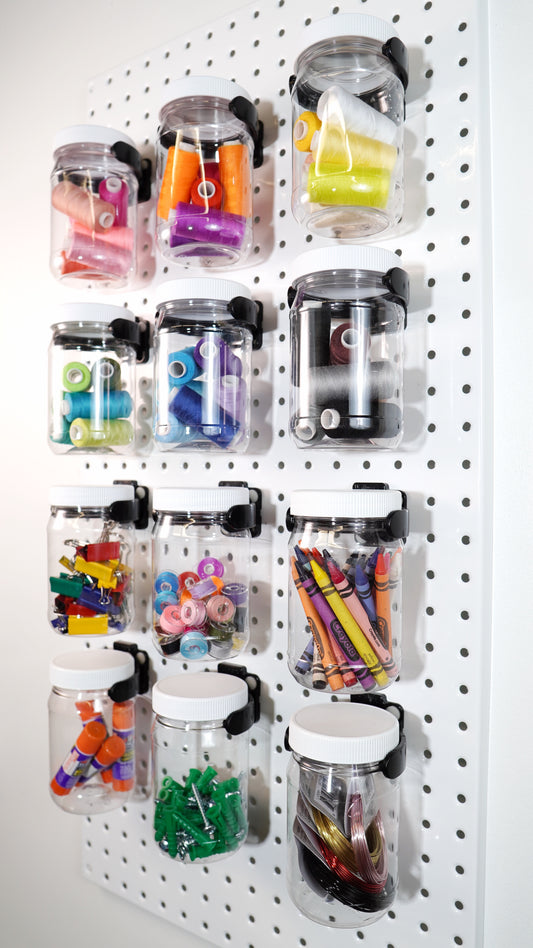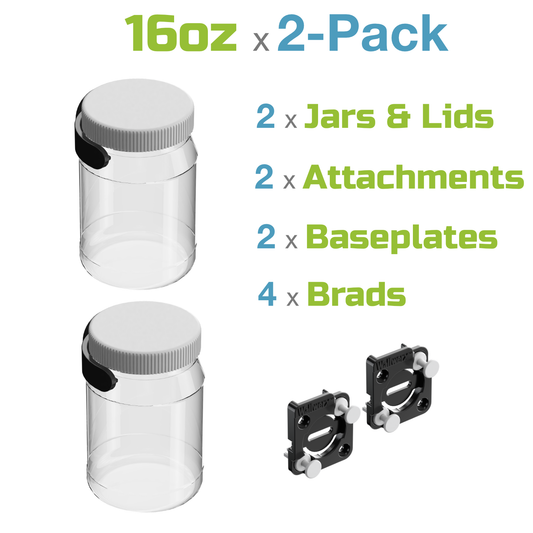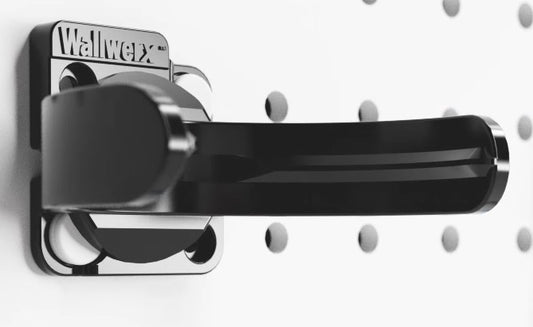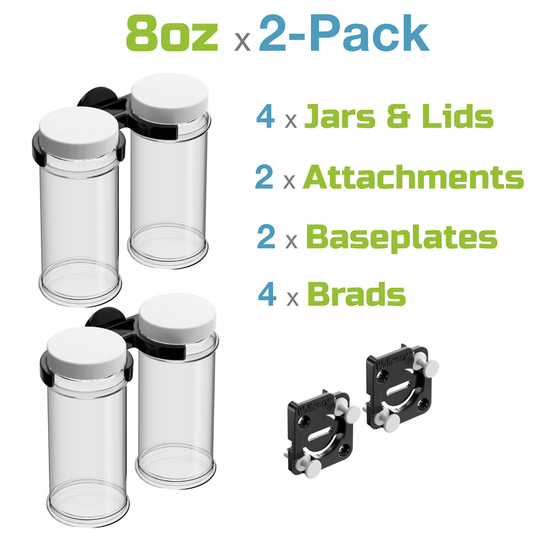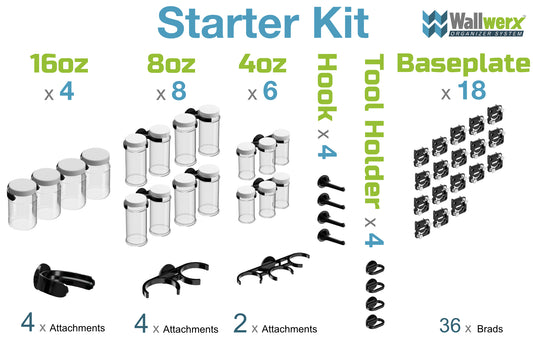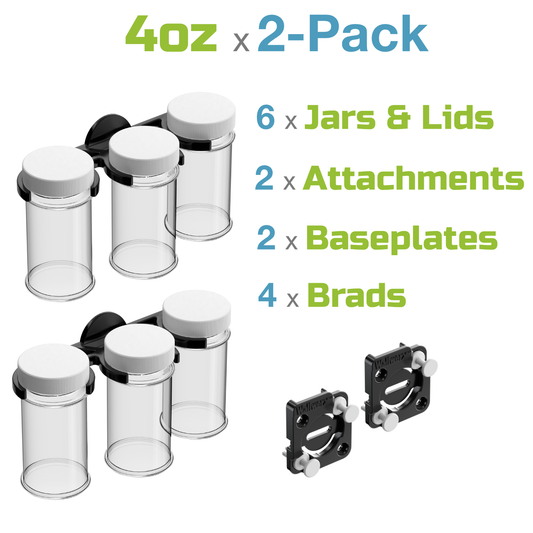Table of Contents
Workbench pegboard accessories by Wallwerx
Wallwerx workbench storage & organization system
Workbench Basics
What is a workbench?
A workbench is a flat surface or table that is used as a work surface for various tasks such as woodworking, metalworking, electronics, or any other type of project that requires a stable and sturdy surface to work on. A workbench typically has a solid and durable construction, and may include features such as built-in storage, tool holders, and vise. They are used to hold tools and materials while they are being worked on and also provide a surface to work on. The workbench can be made of different materials such as wood, metal or a combination of both.
Workbenches are commonly used in workshops, garages, and basements. Some workbenches are designed for specific tasks, such as woodworking or electronics, while others are more general-purpose. They come in a variety of sizes and styles, from small portable benches to large, heavy-duty workbenches. They can be store-bought or homemade, depending on the needs and preferences of the user.
Which is the correct spelling: workbench or work bench?
Both “workbench” and “work bench” are correct spellings.
In general, “workbench” is more commonly used as a single word, especially in industrial and professional settings, while “work bench” is more commonly used in the context of DIY and home improvement.
It’s worth mentioning that both terms refer to the same thing, a table or bench that is used as a work surface for various tasks such as woodworking, metalworking, electronics, or any other type of project that requires a stable and sturdy surface to work on.
Workbench Dimensions, Features and Accessories
What are the ideal dimensions of a work bench?
The ideal dimensions of a workbench will depend on the type of work you plan to do on it and the space you have available. Generally, a workbench should be at least 36 inches high, which is a comfortable working height for most people. The width should be at least 30 inches, to provide enough space for your tools and materials. The depth can vary depending on your needs, but a minimum of 24 inches is recommended.
What’s the best surface material for a workbench?
The best surface material for a workbench will depend on your specific needs and preferences. Some common options include:
-
Hardwood: Hardwood is a durable and attractive option for a workbench surface. It is resistant to scratches and dings, and can be easily refinished if it becomes damaged.
-
Plywood: Plywood is a strong and inexpensive option for a workbench surface. It is easy to cut and shape, and can be finished with a variety of materials to make it more durable.
-
MDF: Medium-density fiberboard (MDF) is a popular option for workbench surfaces. It is smooth, flat, and stable, and can be painted or laminated for a durable finish.
-
Metal: Metal surfaces like steel or aluminum are very durable and easy to clean, but not as comfortable to work on as wood surfaces. They are good for heavy-duty tasks and electrical work.
-
Laminate: Laminate surfaces are durable and easy to clean, but they can be slippery and can be damaged by heat.
Ultimately, the most important factor is the durability and suitability for the type of work you will be doing on your workbench. A good surface material should be easy to clean, durable, and comfortable to work on.
What are workbench fittings?
Workbench fittings are accessories or attachments that can be added to a workbench to enhance its functionality and versatility. Some common examples of workbench fittings include:
-
Vises: Vises are clamps that can be attached to a workbench to hold materials in place while working on them. They can be useful for tasks such as sawing, drilling, or sanding.
-
Drawers and Cabinets: Drawers and cabinets can be added to a workbench to provide storage for tools and materials. They can be useful for keeping the workspace organized and for keeping tools and materials within easy reach.
-
Lighting: Lighting can be added to a workbench to improve visibility and accuracy when working on tasks.
-
Tool holders: Tool holders can be added to a workbench to keep tools organized and easily accessible. They can include holders for screwdrivers, pliers, wrenches, and other hand tools.
-
Bench dogs: Bench dogs are small, cylindrical devices that can be inserted into holes drilled into a workbench. They are used to hold the workpiece steady and level while working on it.
-
Bench stops: Bench stops are similar to bench dogs, but they are wider and longer, they are used to prevent the workpiece from sliding around the bench surface.
-
Bench grinder: A bench grinder is a machine that can be attached to a workbench and it can be used to sharpen, grind or smooth metal or other materials.
-
Power strip: A power strip can be added to a workbench to provide easy access to electrical outlets for power tools and other devices.
Overall, workbench fittings can be a great way to enhance the functionality and versatility of a workbench, and can make it more efficient and convenient for the user to complete their projects.
What are some workbench space savings techniques?
Here are some techniques to save space when building or organizing a workbench:
-
Wall-mounted: A wall-mounted workbench can be folded up when not in use, saving floor space.
-
Fold-down: A fold-down workbench can be mounted on the wall and folded down when in use. This allows you to have a large work surface when you need it, but saves space when it’s not in use.
-
Multi-functional: A workbench that serves multiple purposes, such as a table saw, drill press, and router table combo, can save space by eliminating the need for multiple separate tools.
-
Under-bench storage: Utilizing the space under a workbench for storage can be a great way to keep tools and materials organized and easily accessible while saving space.
-
Overhead storage: Installing shelves or a pegboard above the workbench can be a great way to keep tools and materials organized and out of the way, while saving space on the workbench.
-
Rolling: Using a workbench with wheels can make it easy to move around when needed, and to store it in a corner or against a wall when not in use.
-
Minimalistic: Keep only the essential tools and materials on the bench, and store the rest elsewhere. This will make the bench less cluttered, and easier to use.
Ultimately, the key to space-saving techniques is to be creative and think about how to make the most of the space you have.
What kind of pegboard should be installed above a workbench for organizing and storing materials?
When installing a pegboard above a workbench for organizing and storing materials, there are a few things to consider:
-
Material: The most common materials used for pegboards are wood, metal, and plastic. Metal and plastic pegboards are more durable and resistant to moisture than wood, but wood can be painted or stained to match the workbench.
-
Size: The size of the pegboard should be based on the size of your workbench and the number of tools and materials you need to store. A standard size pegboard is 4 x 8 feet, but you can also find smaller or larger sizes.
-
Holes: The spacing and size of the holes in the pegboard will determine the type of hooks and accessories that can be used. Standard pegboard holes are 1/4 inch, but you can also find pegboards with smaller or larger holes.
-
Accessories: Look for pegboard accessories that can help you organize your tools and materials, like hooks, trays, and holders, also find a good balance between the size of the pegboard and the size of the accessories.
-
Installation: The pegboard should be securely mounted to the wall, making sure that it can support the weight of the tools and materials you plan to store on it.
Overall, a metal or plastic pegboard with standard 1/4 inch holes and a good selection of accessories is a great option for a workbench, as it will be durable and versatile. A high-quality pegboard should be able to withstand heavy use and should be able to hold a variety of tools and materials without bending or breaking.
Workbench Uses and Types
Are workbenches good for assembly projects?
Workbenches can be very useful for assembly projects as they provide a stable and flat surface for working on, and can be equipped with various tools and storage options to make the assembly process more efficient. Some of the benefits of using a workbench for assembly projects include:
-
Stability: A workbench provides a stable surface for working on, which is important when assembling small parts or delicate pieces.
-
Height: A workbench is typically higher than a standard table, which can be more comfortable for working on assembly projects that require standing.
-
Lighting: Many workbenches come with built-in lighting or have the option to add it, which can be very helpful when assembling small parts or working on projects that require precision.
-
Storage: Workbenches often have built-in storage or the option to add it, which can be very useful for keeping tools and materials organized and easily accessible while working on assembly projects.
-
Clamping: A workbench can also have clamping options, which can be very helpful when working on projects that require holding or securing parts in place while assembling.
-
Surface: A workbench surface can be made of a variety of materials, such as hardwood, plywood, MDF, and laminate. These materials can be very durable and easy to clean, which can be important when working on assembly projects that produce small parts, dust or debris.
Overall, a workbench is a great option for assembly projects due to its stability, height, lighting, storage and clamping options, as well as its surface material.
What are some alternatives to using a workbench?
While workbenches are a popular and versatile option for many types of projects, there are some alternatives that can be used depending on the task at hand and the space available. Some alternatives to using a workbench include:
-
Table: A standard table can be used as a workspace for many types of projects. It can be a good option if you don’t have a lot of space or if you need a portable workspace.
-
Work table: A work table is a larger, more heavy-duty version of a standard table. It is typically made of steel or aluminum and can be used for more demanding projects, such as welding or woodworking.
-
Saw horses: Saw horses are a simple and inexpensive option for a workspace. They can be used to support a piece of plywood or other flat surface to create a makeshift workbench.
-
Workstations: Workstations are a more elaborate and specialized alternative to a workbench. They are designed for specific tasks such as woodworking, metalworking, or electronics.
-
Floor: Depending on the task, sometimes the floor can be used as a workspace. A rug or mat can be placed on the floor to protect it and make it more comfortable to work on.
-
Portable workbench: Portable workbenches are lightweight and collapsible, they can be easily transported and stored, they can be a good option for people who need to move their workspace around.
Overall, the best alternative to a workbench will depend on the task at hand.
Are industrial workbenches different than home workbenches?
Industrial workbenches and home workbenches can be quite different in terms of their design, construction, and features.
Industrial workbenches are typically designed for heavy-duty, industrial use and are built to withstand harsh environments and heavy loads. They are often made of steel or other durable materials and are designed to withstand heavy use, vibration, and impact. They also can have more complex features such as built-in electrical outlets, adjustable height, and built-in storage.
Home workbenches, on the other hand, are typically designed for lighter-duty use and are often made of wood or other lighter materials. They may have a more decorative design, and they may not be as durable or heavy-duty as industrial workbenches. They are also less likely to have built-in electrical outlets, adjustable height, and built-in storage as well.
Additionally, industrial workbenches are often used in commercial and professional settings, such as factories, warehouses, and repair shops, where they are subjected to heavy use and require high-quality construction and durability. Home workbenches, on the other hand, are often used for personal projects, and may have less demanding requirements.
In summary, industrial workbenches are built to withstand harsh environments, heavy loads and are often outfitted with features ideal for a work setting.
What is a workbench versus an assembly table?
A workbench and an assembly table are both types of work surfaces, but they have some key differences in terms of their design and intended use.
A workbench is a general-purpose work surface that can be used for a wide variety of tasks, such as woodworking, metalworking, electronics, or any other type of project that requires a stable and sturdy surface to work on. A workbench typically has a solid and durable construction, and may include features such as built-in storage, tool holders, and vise.
An assembly table, on the other hand, is a specialized work surface that is designed specifically for the purpose of assembling components or parts together. An assembly table is typically larger than a workbench and has a flatter, smooth surface. It may also include features such as built-in clamps, stops, or guides to help hold the components in place while they are being assembled.
One key difference between a workbench and an assembly table is that a workbench is often used for various tasks such as cutting, sanding and drilling, while an assembly table is used primarily for assembling components or parts together. An assembly table is often used in industrial settings or manufacturing facilities, where large numbers of products are assembled.
In summary, while both a workbench and an assembly table are types of work surfaces, they are designed for different purposes and have different features that cater to different types of tasks. A workbench is more versatile, it can be used for various tasks, whereas an assembly table is more specialized and designed for assembling components or parts together.
Where should a workbench be located in a garage?
A workbench can be located in a variety of places in a garage, depending on the size of the garage and your personal preferences. Some common locations include:
-
Against a wall: This is a popular option as it allows you to utilize the wall for hanging tools and storage.
-
In a corner: This is a great option if you have limited space and want to make the most of it.
-
In the center of the garage: This is a good option if you have a large garage and want to have plenty of room to move around the workbench.
-
Dedicated area: If you have a large garage and plan on doing a lot of work, you may want to dedicate a specific area of the garage for your workbench.
Ultimately, the most important consideration when choosing a location for your workbench is that it should be well-lit, have access to electrical outlets, and be near enough to your power tools.
Are there adjustable height workbenches? When would one be useful?
Yes, there are adjustable height workbenches. These workbenches can be adjusted to different heights to accommodate different users and tasks. They are also known as sit-stand workbenches.
An adjustable height workbench can be useful in a variety of situations, such as:
-
Ergonomics: An adjustable height workbench can help to reduce strain and fatigue on the user’s body by allowing them to adjust the height of the work surface to a comfortable level. This can be especially useful for people who spend a lot of time working at a workbench.
-
Multi-task: An adjustable height workbench can be useful for multiple tasks, as it allows the user to easily adjust the height of the work surface to match the task at hand. For example, it can be raised for standing tasks and lowered for sitting tasks.
-
Multi-user: An adjustable height workbench can be useful in a shared workspace, as it allows multiple users to adjust the height of the work surface to their own comfort level.
-
Specialized tasks: An adjustable height workbench can be especially useful for tasks that require precision and accuracy, such as electronics or jewelry making, where the user may need to sit or stand at different heights to get the best view of their work.
-
Accessibility: An adjustable height workbench can also be useful for people with disabilities or mobility issues, as it allows them to adjust the height of the work surface to a level that is comfortable for them.
Adjustable height workbenches come in manual or electric versions, manual workbenches require the user to manually adjust the height by using a crank or lever, whereas the electric workbenches have a button or control to adjust the height. Both versions are quite useful and can cater to different needs and preferences.
Workbench DIY and Selection
How do I build a workbench out of wood myself?
If you want to Do It Yourself, building a DIY workbench out of wood is a relatively straightforward process, but it does require some basic woodworking skills and tools. Here is a general guide on how to build a wooden workbench:
-
Gather materials and tools: You will need to gather all of the materials and tools that you will need for the project. This will include wood for the top and legs, hardware such as screws and bolts, a saw, a drill, a hammer, and a measuring tape.
-
Measure and cut the wood: Measure and cut the wood for the top and legs of the workbench. The size of the workbench will depend on your needs, but a common size is 72 inches long by 36 inches wide. The thickness of the top should be at least 2 inches, the legs and crossbars should be 4×4 or 6×6 inches
-
Assemble the frame: Assemble the frame of the workbench by attaching the legs to the top with screws or bolts. Make sure to use a square to ensure that the frame is square and level.
-
Install crossbars: Install crossbars between the legs to provide additional support and stability.
-
Sand and finish: Sand the workbench to smooth out any rough edges or surfaces and to remove any saw marks. Then apply a finish of your choice to protect the wood and give it a polished look.
-
Add fittings: Once the workbench is finished, you can add any fittings or accessories that you desire such as a vise, tool holders, or drawers.
It’s important to note that this is a basic guide, you can always add more complexity or design to your workbench, you can also use different type of wood, or use a combination of wood and metal.
Which workbench is the best?
There is no one “best” workbench as it depends on the intended use and personal preferences. The best workbench for you will depend on the type of projects you plan to work on, the space you have available, and your budget. However, here are some factors to consider when choosing a workbench:
-
Size: Consider the size of the workbench in relation to the space you have available and the size of the projects you plan to work on.
-
Durability: Look for a workbench that is made of sturdy and durable materials, such as hardwood or steel.
-
Stability: Make sure the workbench is stable and won’t wobble or tip over when in use.
-
Adjustability: Some workbenches have height-adjustable legs, which can be useful for different projects and users.
-
Storage: Some workbenches have built-in storage, such as drawers or shelves, which can be useful for keeping tools and materials organized.
-
Clamping: Look for a workbench that has clamping capabilities, this could be through the use of vices, bench dogs or other clamps.
-
Ease of assembly: If you are buying a workbench that needs to be assembled, consider the ease of assembly and if all the necessary hardware and instructions are included.
It’s important to note that some brands and manufacturers specialize in specific types of workbenches. For example, some brands are known for heavy-duty industrial workbenches, while others are known for their high-quality woodworking workbenches. Researching different brands and models can help you find the best workbench for your specific needs.




